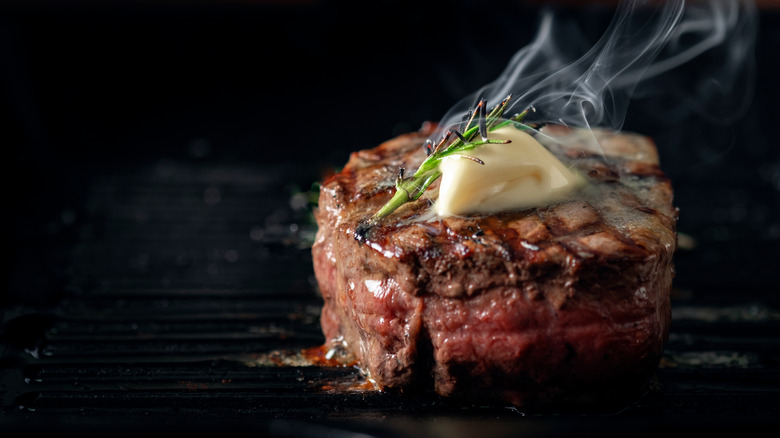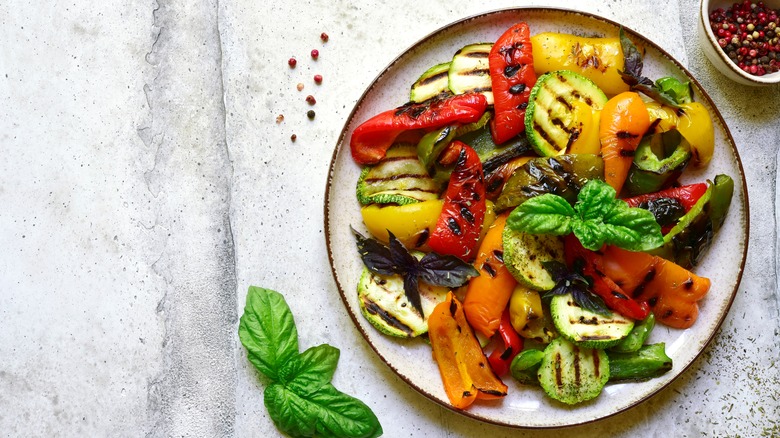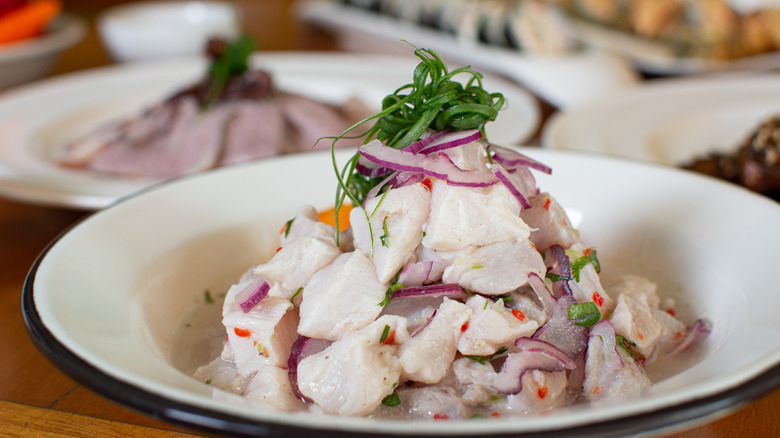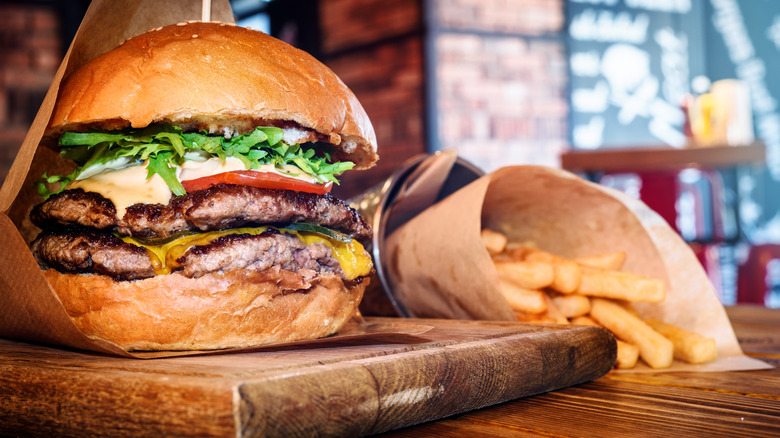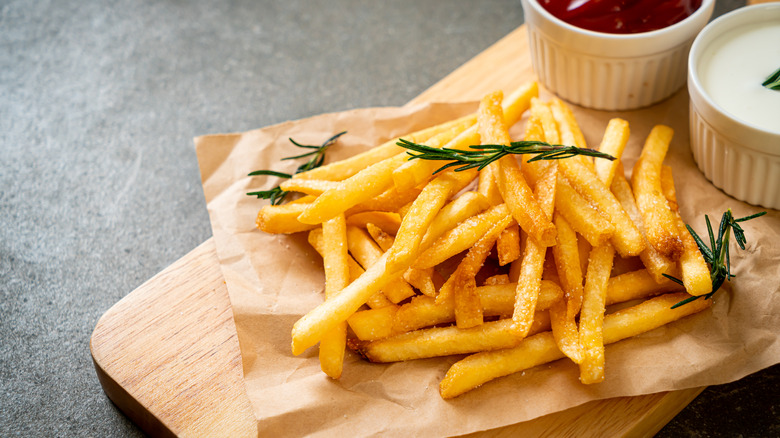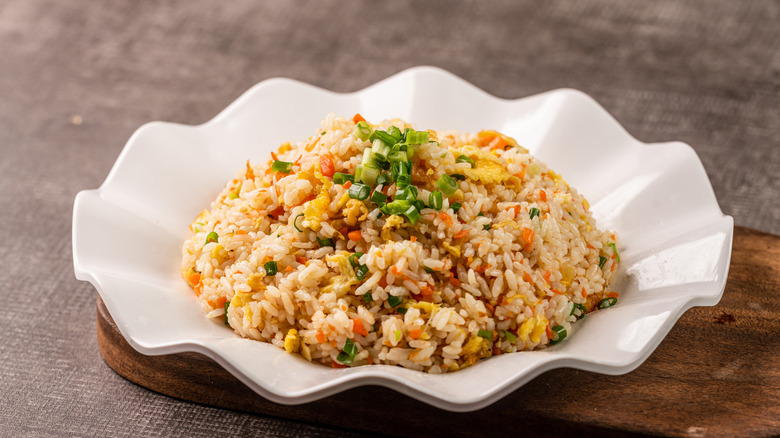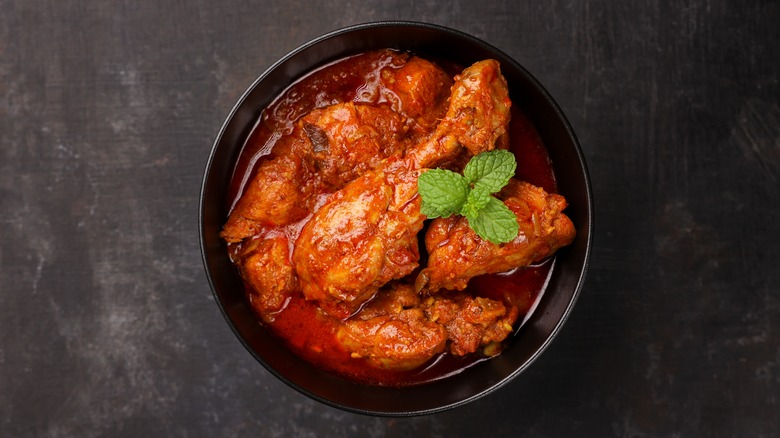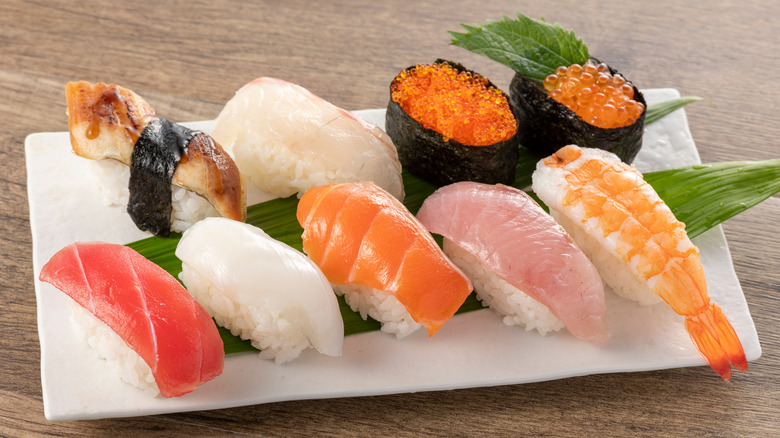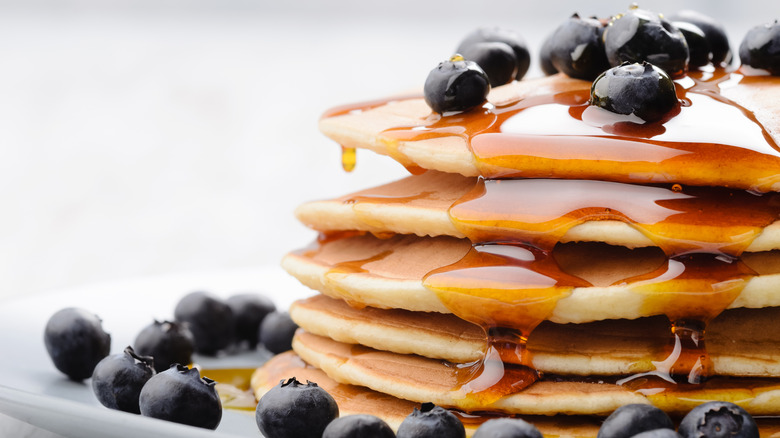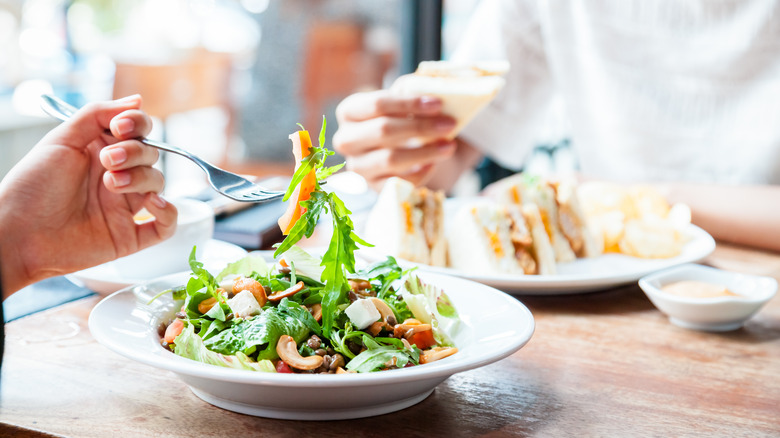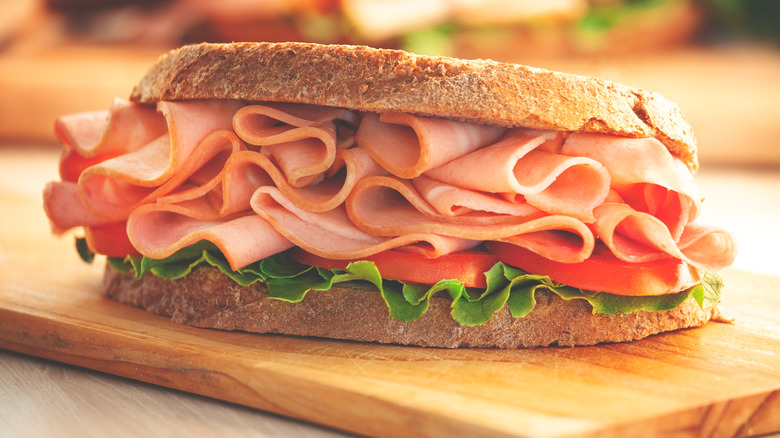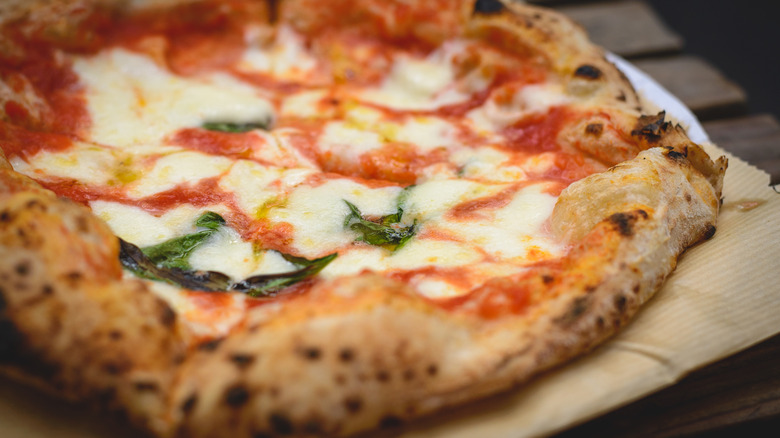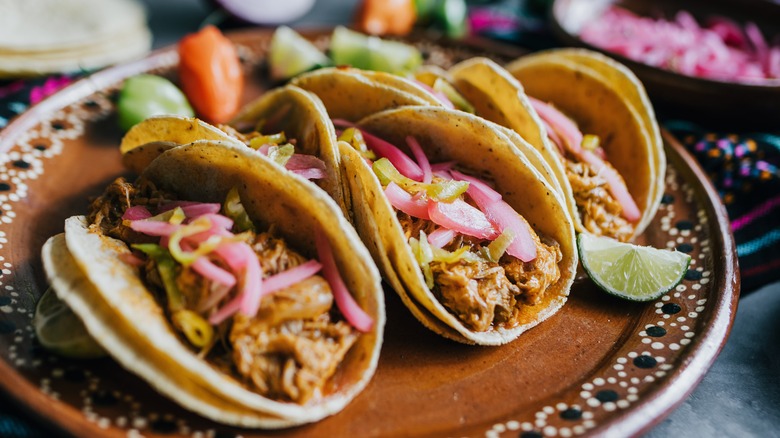14 Foods That Always Taste Better At Restaurants
It's often said that you can't beat a home-cooked meal. The comforting smells drifting through the home, the satisfaction of getting your timings just right, and the joy of serving up a bowl of something comforting to your family and friends. It's no understatement to say that cooking at home is one of the best ways to spend your time. Making your own food isn't just beneficial for your mood, either. It can help you control what you're eating, boost and support your health, and allows you to keep an eye on food safety.
But, friends, here's the truth: While a homemade plate of food can be hard to top, some meals are just better in restaurants. On average, Americans spend more than an hour a day in their kitchens, adding up to 400-plus hours a year, per StudyFinds. But in reality, you can spend the majority of your evening trying to make the best meal possible, and if you're cooking certain dishes or items, you'll never quite make it as a restaurant does. So, we wanted to save you valuable time and effort, by putting together all the foods that will always taste better at restaurants. Grab your coat. We're eating out tonight.
Steak
Of all the things that you should pay a chef to make, steak has to be one of the top choices. Few foods are harder to perfect to restaurant quality than a premium cut of beef — and too many times, people have paid huge amounts of money for high-grade steak, only to ruin it when they get home.
But why does steak always taste better at a restaurant? It comes down to multiple factors, all of which are tricky to replicate in your kitchen. The first is where they get their steaks. Steakhouses with a good reputation usually have close ties to suppliers and butchers, who will supply them with the best quality product and cuts. These places aren't just going out and picking up a package at the supermarket.
Heat also plays a major factor. In a restaurant kitchen, industrial cookers and broilers are used that can reach a screamingly-high temperature, which gives your steak a sear that supplies it with flavor, while keeping it rare in the middle. Restaurants generally also use specialized pans made of carbon steel, which retain heat effectively, again contributing to that all-important browning.
If you want to make restaurant-quality steak at home, though, there is one thing that can help: butter. Many restaurants hit their meat with lashings of creamy fat to support the meat's flavor. They often use compound butter flavored with additional ingredients, though, which can be harder to imitate at home.
Vegetables
Vegetables are food that can be unbelievably boring, totally life-changing, and virtually everything in between. And most of us have had the experience of ordering a vegetable dish in a restaurant, being blown away, and trying to replicate it for dinner the next day, only to fall flat on our faces.
The reason restaurant vegetables taste so good, and yours don't, is usually because the cooks are throwing some extra goodies in there. Restaurant vegetables, more often than not, are laden with butter, which adds richness to the dish. What's more, chefs tend to also hit their veggies with salt and sugar in far greater quantities than you might use at home.
These additional ingredients support the natural flavors of the vegetables used. Naturally, though, they also somewhat take away from the nourishment that vegetable-based dishes can provide. So, remember that when you're making veggies at home, they may be slightly more healthy than those you'd get in a restaurant. Chefs in restaurant kitchens are also adept at using herbs and spices that complement the unique taste of specific vegetables, another reason why they may taste much better when you order them.
Ceviche
Anyone who's ever made ceviche at home will know how disappointing it can be. No matter how hard you try, no matter how hard you read the recipe, you can end up with a bowl that's soggy, limp, and bland. What's more, there's always the risk that ceviche, which is made with raw fish, is not just boring when you make it at home, but hazardous due to incorrect preparation.
So, skip the trouble, and make it one of your "restaurant-only" foods. Arguably the main element of a good ceviche is the best-quality fish, advises Dos Caminos executive head chef and former champion of "Hell's Kitchen" Ariel Fox via Insider. In-the-know chefs have access to the best supplies of fresh seafood, which your local store just can't replicate.
Furthermore, restaurant cooks have the necessary skill level to know when their ceviche is both ready to serve and safe to eat. "The lime juice and citrus the seafood soaks in may make the seafood appear to be cooked, but it isn't always the case, resulting in a home cook consuming fish that's actually still raw and not safe to serve," says Fox. Chefs, on the other hand, know when the food is both ready and at its most delicious.
Burgers
Ordering a burger at a restaurant can sometimes feel like a bit of a cop-out. After all, you have a grill in your backyard, so why would you waste the money on something you can make at home?
Because if you've ever eaten a restaurant burger and then had a homemade one shortly after, you'll know that the two just don't compare. What makes restaurant burgers taste different from homemade burgers is a combo of ingredient quality, equipment, and cooking technique. Chefs don't just use any old ground beef from the store, but instead usually source grass-fed or grass-finished meat, from a trusted source. Their fat-to-meat ratio is also a bit more generous than you might think, with cooks favoring a 20/80 split.
One of the main tools that chefs have in their arsenal for burger perfection, though, is a griddle. Less common in home kitchens, super-hot griddles give restaurant burgers an even browning, and let the chefs do things like steam the cheese directly onto the meat, providing a superlative melt. Burger cooks also know how to season their meat to perfection, avoid flipping their patties endlessly, and understand how best to put specific burgers with the right cheese, buns, and toppings. It may look like a simple sandwich, but a lot of work goes into a good burger.
French fries
Oven-cooked fries may be a quick way to get your potato fix, but let's be real here for a hot sec: They're not the best, and we all know it. Anyone who's anyone knows that to get the best french fries, you have to fork out a little cash in a restaurant. But why is that the case?
Well, there's one reason and one reason alone: The double-fry. You can nail every stage of your french fry preparation, but unless you're frying them twice, as restaurants do, you'll never get the same result. Restaurants use specialized deep-fat fryers set at different temperatures, with the first round of cooking occurring at a lower heat, for a longer time. This lets the fries cook through properly, ensuring that you won't be biting into a mouth of uncooked potato.
Then, chefs take these fries and finish them off with a blast in a hotter oil bath for a minute or two. This gives them that supremely crisp texture. Restaurant cooks also know the optimal time to add salt to fries, ensuring that they have maximum flavor in every bite.
Fried rice
For such a simple dish, fried rice can be devilishly difficult to master at home. Even the best home cooks will be familiar with the sad sight of a soggy, under-seasoned bowl of fried rice. More to the point, homemade fried rice can often lack a certain je ne sais quoi, that smoky, umami-rich flavor that seems to only be present when it's made by a chef.
And so, when you add in how cheap it can be in comparison to other meals, it's clear that this is a meal that you should be ordering from a restaurant. That "je ne sais quoi" is the taste of "wok hei," a large reason why fried rice tastes better at a restaurant than at home. Wok hei occurs when the rice is fried at a seriously hot heat, in a wok over a direct roaring flame. This high temperature, combined with constant stirring, gives the rice a slightly charred taste and an unbeatable complexity. When you cook fried rice at home, you often can't reach the same heat, and this results in the rice steaming instead of frying properly.
Curry
There are some restaurant dishes that you can make near-perfect imitations of at home, and as you now know there are some that are pretty much impossible to get right. Curry is one of the latter. Restaurant curries are a perfect marriage of multiple spices and elements that come together to create a flavor sensation.
It's not just the spices, though. Curry made in restaurant settings is often full of delicious additions like cream and butter, as well as salt and sugar to boost flavor. This does, unfortunately, have the effect of sometimes pushing restaurant curries into slightly unhealthy territory — as with creamier dishes, the amount of full-fat dairy used can be quite extensive. Arguably, though, if you're going to treat yourself, it's far better to do so in a restaurant than when making a potentially sub-standard curry at home.
There's also the experience and technique of the chef to consider. Chefs that specialize in making curry are well-tuned to the unique balance of spices and heat that individual dishes require and have a knowledge of when to increase or decrease specific amounts. Unless you have the same level of ability, it's best to leave this one to the experts.
Eggs Benedict
Eggs Benedict looks pretty simple, right? That's what most of us think until we try and make it for the first time and fail miserably. Eggs Benedict is a meal that relies on getting each individual element right, and one poorly-executed part can lead to a flat-tasting breakfast. And arguably the most important ingredient, the poached egg, is the hardest of all to master.
This is partly why Hotel Plaza Athenee's executive sous chef Oliver Keegan recommends that Eggs Benedict is a restaurant-order-only meal, via Insider. Making a perfectly poached egg is tricky, and can often result in the yolk being cooked through too much, or else the whole thing can be a runny mess. Add to that the fact that the Hollandaise sauce that adorns the eggs is also surprisingly complicated and labor-intensive to make, and it's little wonder that even the experts say that you should just buy it when you're out. "This is indeed way easier to order, as it is very time-consuming to make from scratch at home," says Keegan.
Sushi
On the surface of things, making sushi might seem easy. Sure, it can be a bit fiddly to cut everything to the perfect size and put it together, but given that it's often just rice, fish, and a few other additions, how hard can it be?
Making sushi is super hard. Sushi is a more expensive food item for a few reasons, one of which is that to make it good, you need the very best fish and sushi rice, which you may not have access to. Furthermore, when you pay money for sushi in a restaurant, you're also paying for the skills of the expert chef making it. A sushi chef, known as an "itamae" in Japan, generally undergoes a 10-year apprenticeship to train fully in the art of making this unique food. While training, the chef will become familiar with every element that goes into making sushi, from preparing the rice to choosing the best fish to putting it all together with love, skill, and care. Forgive us for being a little blunt, but we don't think your attempts at making it in your kitchen will stand up to the mastery of these chefs. We'd say you're better off paying the money and getting a mindblowing meal in return.
Pancakes
Saying that pancakes should only be ordered in a restaurant feels a bit strange, given how easy they are. With most pancakes made using a fairly simple batter, it seems like a food that even a novice cook can get right.
But if you want a truly exemplary stack of pancakes, ordering them is the only way to go. This is because, in restaurants, pancakes are usually made using a large flat-top griddle. This griddle provides uniform heat and a huge surface area upon which pancakes can sizzle away. The size of most restaurant griddles means that the chefs can cook loads of pancakes at the same time, which gives you a towering stack that's warm all the way through. If you're making them at home in a frying pan, you'll always end up with some colder, soggier pancakes at the bottom.
Restaurant chefs are also (generally) able to cook any toppings you desire on your pancakes alongside them on the griddle, like bacon and eggs, serving it all up in one go. There is a solution to this, though. Buying a stovetop griddle can help emulate that restaurant effect in your own home. Just make sure you get one big enough to make the ultimate stack.
Salads
If you're the kind of person who turns their nose up at salads when you're at a restaurant, we'd urge you to think twice. Salads are not just thrown together casually in eateries. More often than not, they're created with love, care, and ingredients that take them far beyond what you might fish out of your fridge.
One reason why salads taste better from a restaurant is because of the seasoning that goes into them. Chefs typically don't just add seasoning to their dressings, but will also season once the dressing is fully mixed in. This gives the salad an additional pop of flavor and brings out the freshness of the vegetables even more.
Speaking of the dressing, this is a vital element too, with the salad's essential coating whipped up in-house using an abundance of high-quality ingredients. It's a far cry from that bottle of store-bought Caesar that you shake onto your leaves at home. Notably, restaurant chefs may use more fat than you do at home in their dressings. While you might feel like this defeats the purpose of a healthy salad, remember that if you're eating it as a main course, having some fat is vital to satisfy you.
Sandwiches
It seems like a cruel fact of life that the simplest foods to make are also the ones that taste the best when you're eating out. And sandwiches are a prime example of this, as a food that's easy to make, but hard to get just right.
Sandwich-making is an art that deli chefs worldwide have mastered. Rather than use any bread, they specifically pair bread types to the fillings that go inside, which supports the structure of your food and enhances its flavor. Despite the bulging appearance of some restaurant sandwiches, chefs also don't just throw anything between two slices of bread. Most restaurant sandwiches are curated affairs that have had a huge amount of thought put into their fillings, to balance flavors and textures in the meal.
The act of construction is also one that restaurant chefs understand well with their sandwiches. After all, they put so much care into making them that they don't want all the toppings to slip out as soon as you take your first bite. That's why salad is usually on the bottom when you order a restaurant sandwich, with looser items pressed between heavier or coarser layers.
Pizza
Making pizza at home is one of the more fun activities you can do in the kitchen. But try as you might, unless you're a trained pizzaiolo with an industrial-grade pizza oven, you'll never get that 'za up to Neopolitan standards.
Pizza looks easy, but making it is a discipline. In restaurants, pizza dough is carefully created and left for days to rise and develop, giving it its gluten content. Contrary to the sodium-heavy and heavily-flavored pizza sauces you can find in jars in stores, restaurant pizzas are usually covered in a sauce made of just tomatoes and salt. The taste comes from the quality of the ingredients used, with San Marzano tomatoes and Italian 00 flour preferred by Neopolitan pizza chefs.
That quality extends to the toppings, too, with the best cheese, meat, and vegetables used. But the true difference between homemade and restaurant pizza is how it's cooked. To get a restaurant-quality pizza, you need a restaurant-quality oven, a dedicated stone oven that can reach incredibly high temperatures. This gives the pizza a crispy bottom, a lightly charred crust, and a still-soft center. Your kitchen oven, try as it might, will just never get to the temperature you need it to be at to get the same effect.
Tacos
There's something about restaurant tacos that just hits different. Taco chefs have become experts at combining the unique blend of spice and freshness that makes this food staple a winner. But there's one element to restaurant tacos that makes all the difference, and it may not be what you think it is — the tortilla.
"Most people think the filling [of a taco] is the most important part, and while it is crucial, the authenticity of a taco comes from the tortilla," says ChaCha's Latin Kitchen chef Joe Martinez via Insider. Without the right tortilla, your taco will be structurally weak and lack an important flavor element. Restaurants generally have tortilla pans that shape and cook the tortillas to the perfect size and consistency. The tortillas that you pick up off the shelf just don't compare.
Taco chefs also understand that filling a tortilla with as many ingredients as possible isn't the secret to success. Instead, the best restaurants focus on achieving equilibrium, aiming for fewer high-quality fillings. This keeps each bite light, but full of flavor.
Static Media owns and operates Daily Meal, Tasting Table, and Mashed.

